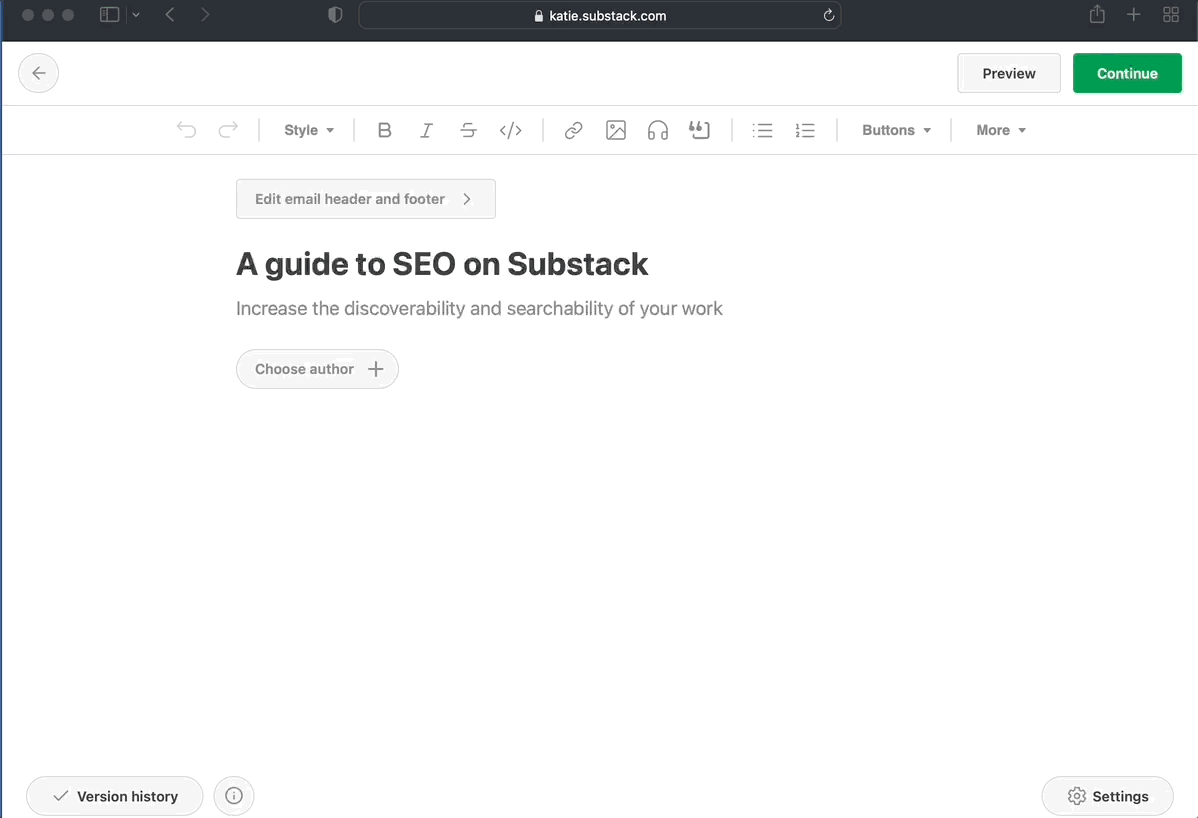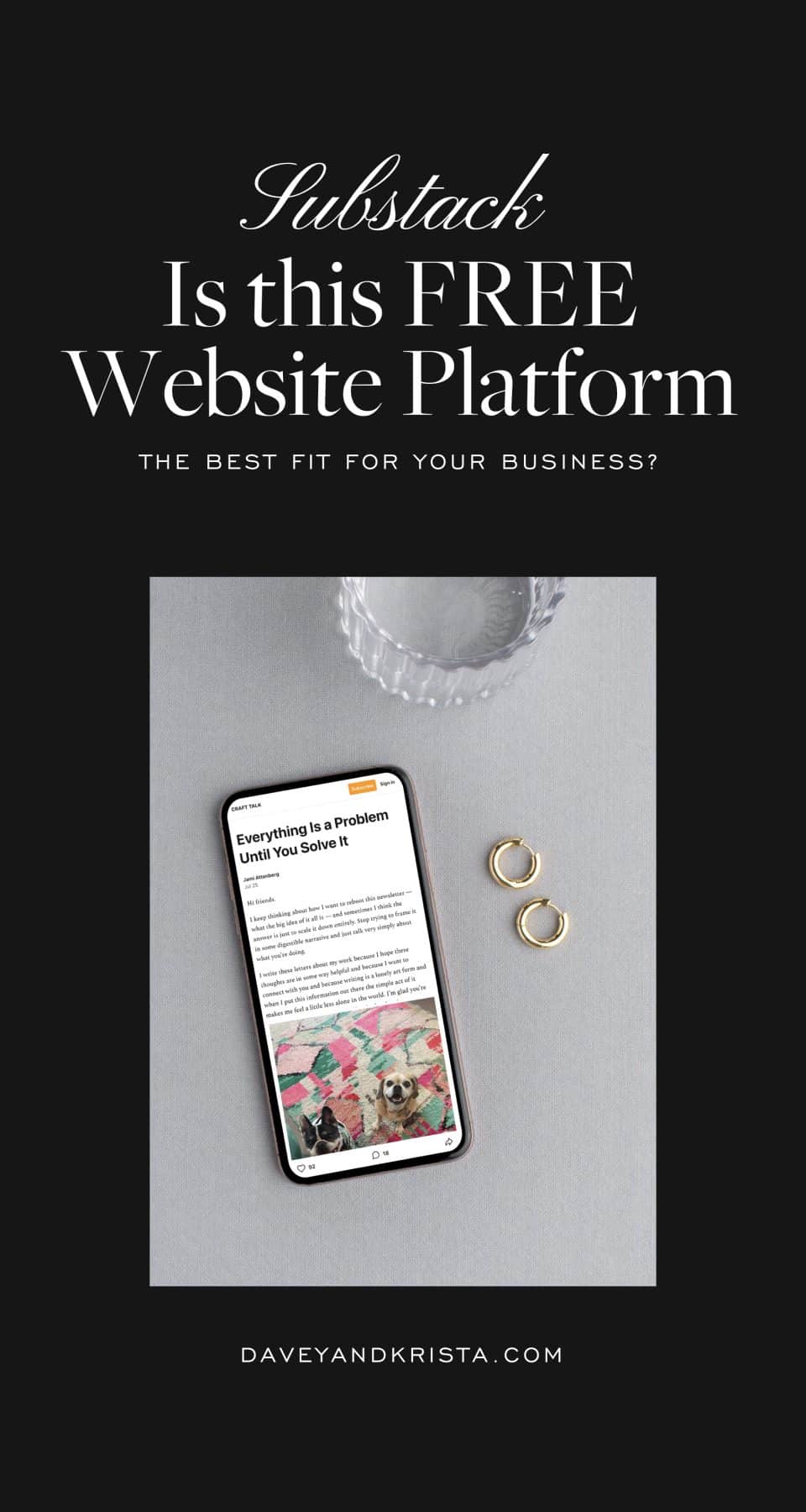First there was Medium, then there was Patreon. Five years ago, Substack launched as a new online publishing platform. Using it, writers are able to form a direct relationship with their audience that they can then monetize.
I created a Substack account almost a year ago to share some personal writing. It was an easy and inexpensive way to create a web presence without asking Krista to create me yet another website 
There is lots to like about Substack, especially how easy they make it to build a list of subscribers.
It’s also not for everyone. If you’re an ecommerce company or a business that needs a feature-rich website, this isn’t the platform for you. But, if you’re a writer or a content-creator (think podcaster), this is definitely a platform to explore.
Let’s dive into our Substack review and discuss whether the platform is right for you.
What is Substack?
Substack was designed to allow creatives—especially writers—to freely share their work online and be paid to do so.
Substack creators build a subscriber list by publishing quality content and demonstrating that their ideas are worth paying to read or listen to. In turn, subscribers pay a monthly fee for access to the newsletters that arrive in their inboxes periodically. Writers can choose on a case-by-case basis which pieces are free and which ones are paid content.
New creators generally start with free content, build a subscriber list, and transition to offering paid content. Well-known figures—people like historian Heather Cox Richardson and author Sarah Bessey—are often able to launch their profile and begin publishing paid content immediately.
For writers, the platform makes it easy to publish digital newsletters and monetize them by putting some content behind a paywall.
For readers, Substack allows them to follow and support the individual voices they’re interested in hearing. Instead of paying a monthly subscription for Forbes or The Food Network to receive access to their content, you can receive newsletters from particular writers. Not only does this provide access to the content you really want to read, but it also supports people rather than corporations.
Who Uses Substack?
Anyone can use Substack—it’s home to bloggers, business writers, reporters, journalists, and others. It lists 27 categories, spanning from technology to comics to crypto. However, if your goal is to market your product or service, Substack probably isn’t the best fit for you: it’s best for content-based businesses.
While Substack houses mainly written content, it also hosts podcasts and videos. This can come in handy for people looking to centralize their content into a single platform, especially if they don’t want to host it all themselves.
While almost anyone *can* use Substack, you might be wondering who is it best for?
→ Those with a small or nonexistent budget. Substack doesn’t charge people to use the platform but instead takes a percentage of what its users earn.
→ Niche writers. If you want to write about a very particular topic, Substack can help you connect with an audience that’s interested in your unique niche.
→ New writers. Some people just want a chance to get their writing out into the world. It’s almost effortless to publish on Substack, and since it comes with the opportunity to build an income stream, it’s a first-rate choice.
Why Substack?
Substack is a great low-cost way to start sharing content, whether it’s written, podcast, or video.
- Setup is easy. Most users are able to set up their profile in less than 20 minutes, and since you go through the platform to sign up and design your publication, it requires no tech knowledge. If you already have an email list, you can import it from WordPress, Mailchimp, Revue, Medium, and several other platforms. It took me less than an hour to set-up my Substack account.
- You’re never stuck. Publishing your content on someone else’s site can be dicey, but Substack aims to provide true independence; you own all of your content and your subscriber list. Anytime you want to leave the platform for a different one, you’re free to go and take your emails and list with you.
- Writers have strong creative freedom. Working with any client or publication comes with limits and expectations. These aren’t inherently a bad thing, but they do mean that you’re working within someone else’s confines. On Substack, you aren’t beholden to anyone but your readers.
- It’s free. Creators don’t pay any hosting or design fee. You simply create your account and start publishing. And when you start earning money, Substack takes a 10% cut of the profits.
- There are almost unlimited income possibilities. Monthly subscription fees can range from $5 to $50, though most creators stick to the lower end. In January 2021, Substack had about 250,000 paying subscribers on the platform; by November 2021 that number had multiplied to more than a million paying subscribers. This kind of growth is promising for creators.
- You can use a custom domain. You can link your Substack to a custom domain for a one time, $50 fee (and of course pay an annual fee to the domain name provider). Your own domain communicates the authority of your brand and it removes the barrier of a subdomain, which can prevent your site from ranking well in searches.
- You can build an email list. That Substack prioritizes and makes it easy to build an email list is perhaps its most important feature. This list can be exported too, so if you ever decide to leave the platform you can bring your subscribers with you.
The massive appeal of Substack is that it’s simple. You gather subscribers, you create your content, you publish what you created, and you get paid. With engaging ideas and targeted advertising, you can make at least a small income from writing daily or weekly emails.
Substack Limitations
Overall, Substack is worth looking into, but there are a few things you need to be aware of before you get started.
Your take is less than you think. You won’t actually take home 90% of what subscribers pay. On top of the 10% that Substack keeps, Stripe takes 2.9%, plus $0.30 per transaction (with the average $5 subscription, that’s another 6%). Don’t forget that you’ll be paying taxes on everything you earn as well.
If I ever decide to monetize my website on Substack, I would likely move it to another platform and use an email service provider like Kit. This way I’m not paying as much in fees per each subscriber.
On that note, it’s not ideal if you’re looking to scale your business. If you’re making a few hundred dollars each month from Substack, the 10% cut isn’t too costly. However, make even a thousand dollars a month, and you’re sacrificing $1,200 a year, which is probably more than what it would cost to pay for web hosting and an email marketing platform.
There’s no email customization. Unlike other email platforms, Substack doesn’t provide personalization tag features. Everyone on your list gets the exact same email at the exact same time. There’s no way to–
- use subscribers’ names.
- create conditions for sections of the email.
- create any sort of email sequence or automation.
You’ll have very limited aesthetic control. We’re big on beautiful design around here, so the lack of artistic choice is a bit of a bummer. Substack allows you to select your accent colors, choose from their list of fonts, select between two layouts, and upload your logo. That’s about the extent of it. It makes for super easy set-up, but not much personalization.
In addition, it’s important to remember that Substack makes it easy to publish your content, but you’ll still need to drive your audience to your channel, so be prepared to invest some time (and possibly money) into marketing. Link your Substack on your website, your social media, and even your email signature. Share snippets on social media to draw readers in. Consider pairing your Substack with a traditional WordPress or Showit website that’s more conducive to the long-term goals of your business.
SEO on Substack
We’re frequently asked about whether Substack is good for SEO. In other words, is it possible to rank posts in search engines on Substack?
Initially, I wasn’t so sure. However, Substack has recently demonstrated their commitment to Substack’s SEO abilities in a recent update. Substack provides users with SEO tools that help set their posts up for SEO success. For instance, they added the ability to update the SEO page title and post description (the way a post appears in search) without having to change how the title appears when sent to subscribers via email.

Do We Recommend Substack?
My experience on Substack has been great—but my publication is more of a creative outlet rather than a business. If I were serious about monetizing, I might start on Substack to keep costs low, but move as soon as I felt I was ready to scale.
Substack is for you if…
- You’re looking for a platform that requires little set-up and works well “out-of-the-box.”
- Want to monetize content quickly.
- Want something easy; either not capable (or don’t want to) manage an overly technical set-up.
- Want to be part of a larger writing community.
You may want to consider an alternative if…
- You want total control over your publication: how it looks and how it’s set-up.
- Don’t want to give away such a big commission.
- Need something that can scale into a business enterprise (for instance, if you plan on launching physical products, expanding the brand, etc.)
In general, my experience on Substack has been great and I know plenty of others who have had a similar experience. If you’re a blogger or writer, Substack is one of the first platforms that I would recommend checking out.








VIEW THE COMMENTS
Add A Comment